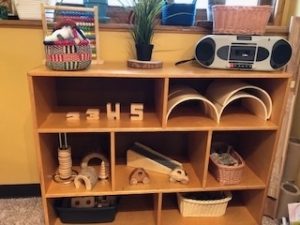Within the Reggio Emilia approach, and now in many early childhood programs, the environment where children spend their time is typically called the third teacher. The environment helps determines the flow of the day, what children learn and how they interact with one another. Having the right amount, variety, and types of materials in an early childhood classroom will make the day run more smoothly and will be more engaging for the children, thus in turn will make it easier for the teacher.
Knowing the why, when, and how to rotate toys is important and a worthwhile task, based upon information gathered through child observations. Through observations of the children in care, we can determine if, when, and what types of materials need to be rotated in the environment. The provider knows the children in their care very well and soon can see patterns emerge that will help the provider make specific adjustments in the environment.
Let’s consider some of the reasons why we rotate toys in a childcare environment.
A child may have mastered a certain skill and by changing specific materials in the classroom we can help scaffold the child to the next skill level. Children learn through facing appropriate challenges, but it’s important to make the challenge achievable. We don’t want the child to feel frustrated or lose interest. A skilled teacher is able to observe students and notice these small changes and find materials that will spark curiosity and interest. We may want to teach a new skill. Placing new toys and materials in the classroom can help a child learn a new skill, such as sequencing, stacking, or balancing. We may also want to challenge that skill and make it slightly more difficult by adding something new to use. Safety is top priority so make sure that items placed in the environment are safe for all ages of the children in the classroom. This can be challenging in multi age programs but can be overcome with a little planning and thought. A child’s individual interests will also play a part in the items we choose. We know that children will play with things that interest them. Having materials of interest will mean the children will explore and play with things that interest them and that are relatable and familiar to them. Common household items that children are familiar with are good to add when possible.
Now let’s take a look at when we might remove certain materials from the classroom environment. When children have lost interest, aren’t playing with as intended or are mistreating the materials, this is a good time to remove them and find materials that the children are interested in. Intended uses of toys and materials may vary from item to item. I believe that a toy does not necessarily have to be used exclusively for its intended purpose. I believe children should be able to use their imagination and creativity and use items in different ways, not just the way intended from the manufacturer. Items that are distracting and stress inducing should be removed. Some children are more sensitive to certain colors, sounds, and even how much is available in the environment for the children at one time. Remember less is more.
Finally, how we display items in the environment helps convey to the children what is expected of them and where items belong. Neatly placing items on a shelf helps children put things away on their own. Labeling shelves and baskets make clean up a breeze. They can also see and reach what they would like to play with, and this allows for independence. Placing similar items together on the shelf in an aesthetically pleasing way, where children can see them shows we care about our materials and toys, and they deserve a place in the space. Don’t over crowd the environment. Less really is more in childcare. If too many choices are available to children, they don’t play well with any of them. Choose items that interest the children and things they are familiar with and see in their day to day lives. We want these items to be relatable to children and familiar. Children want to use “real” things they see in their everyday lives. If teaching a theme, we may want to choose items that relate to the theme being taught or based upon the current season. Rotating 1-2 things a week and making adjustments as needed is less stressful on children than changing everything at one time.
Creating an organized and inviting environment is not difficult. With a little planning and time, you can create a relaxing and organized childcare space to enjoy for children and teachers alike.




